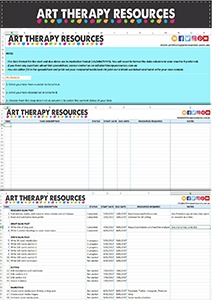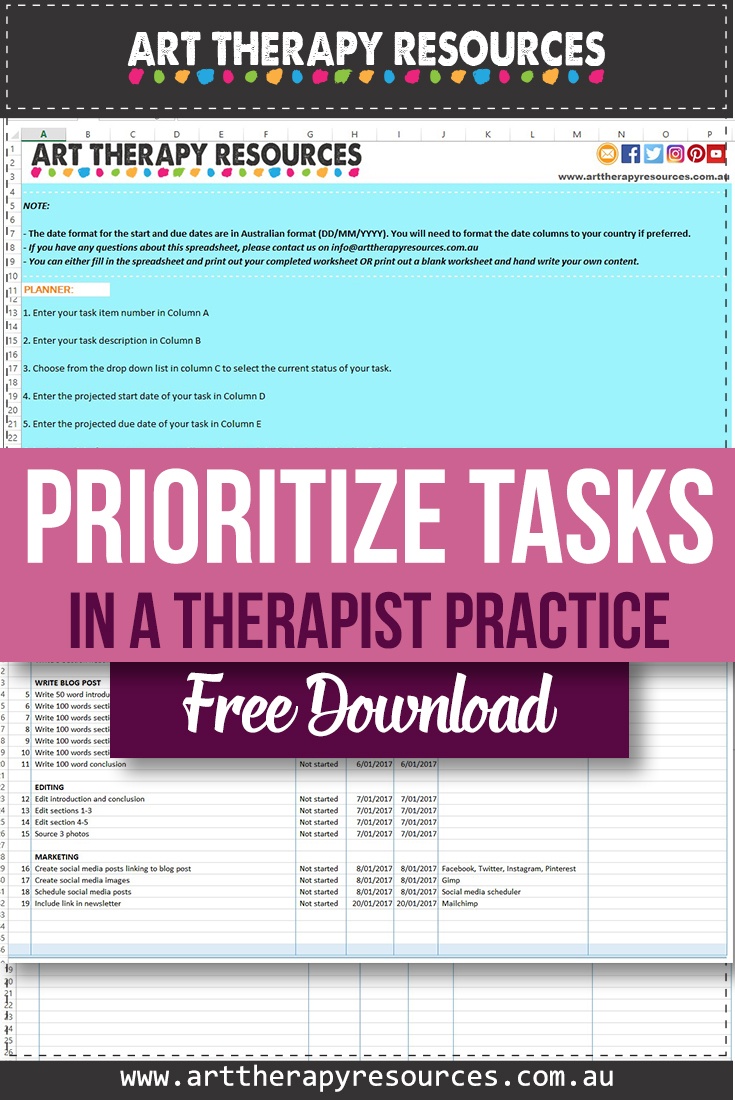THIS POST INCLUDES:
1. The important tasks of a therapist
2. Identify your priorities as a therapist
3. How to prioritize tasks
4. Free Download Planning Template
THE IMPORTANT TASKS OF A THERAPIST
When working on your tasks and priorities as a private practice therapist, it’s a good idea to take the advice you give to your clients. Understand what your limits are and set boundaries to protect your wellbeing. Therapists are already at risk of professional burnout so it’s important not to overwhelm yourself with administrative duties in addition to your therapist duties.
When defining the tasks that are important to you as a therapist, start by collating all your tasks into one single source. This might require that you review various sources where you currently store your work tasks. Below are some of the places we often store our task lists:
- A physical diary/planner
- Whiteboard calendar or planner
- An electronic diary/planner
- An electronic diary in email
- An electronic diary on a mobile device – phone, tablet, watch etc
- Documents on a computer – spreadsheet, word document etc
You may have other sources of information. Review each source and collate all the tasks into one single list. This review may also prompt you to reassess the effectiveness of each source and whether you can eliminate any possible duplicate sources to streamline your workflow.
Every practice will have their specialized task list however the following list is the most common tasks that a therapist will need to do in their practice. This includes both therapeutic tasks and tasks that relate to being a business owner:
THERAPIST TASK LIST
Below are some of the tasks you may undertake in your role as an art therapist:
- Maintain client appointment schedule
- Update client records
- Process new client intake forms
- Respond to client correspondence
- Respond to 3rd party correspondence re: clients
- Clean art therapy space and materials
- Write reports
- Supervision appointments
- Develop psychoeducation handouts
BUSINESS ADMIN MAINTENANCE CHECKLIST
Use this list as a guideline to conduct business maintenance tasks on a monthly or quarterly basis. This list can be found in the Admin Package available in our store.
- Clean out email inbox/archive old messages
- Update sales pages for services
- Create marketing materials for social media
- Create marketing materials for direct advertising
- Review website for functionality
- Review website to update plugins or software
- Review expenses
- Review any tasks that can be automated or eliminated
- Update business financial data
- Record business analytics
- Review annual goals
It is important to identify the tasks you need to do, and it’s also important to identify the tasks you don’t need to do. This will allow you to either eliminate tasks or outsource them to someone else. Some tasks that you eliminate might be due to time constraints even if the task is important to you. This might be something like writing a book or creating an ecourse.
It’s useful to remember that our work requirements are constantly changing. Therefore, even though you may eliminate a task now, you can always introduce it back into your schedule later if time and reason permit.
IDENTIFY YOUR PRIORITIES AS THERAPIST
Even though your task list might contain many items, you need to identify the most important tasks that are a priority to the functioning of your therapy practice.
Your list will require a balance between therapeutic work and administrative work.
You can assess each task and decide whether to keep the task, delegate the task, or eliminate the task. Doing this review will provide you with a streamlined list of tasks to prioritize.
As you identify your priorities you can start to define what tasks must be done based on a daily, weekly, monthly, or annual schedule.
Anything that does not make your priority list then becomes a secondary list for you to make decisions about, such as:
- Can you eliminate the task?
- Can you outsource the task to be done by someone else?
- Can you do the task less frequently?
- Can you reduce the requirements of the task so the task takes less time?
- Can you streamline the task to join other tasks?
HOW TO PRIORITIZE TASKS
A therapist is attuned to identifying priorities all the time as we help clients identify, prioritize, and address their own mental health needs.
This type of work can include assessing motivation and engagement in undertaking specific tasks. Understanding the psychological approach can also help us explore our strengths, barriers, and limitations so that we can make better-informed decisions about the tasks we can complete ourselves or need help to complete.
Once you’ve created your master list of tasks that are to remain on your list, you can undertake the process of prioritizing as below:
Label each item as:
- Urgent – needs to be completed within the next week or month. These items may be one-off tasks that need to be completed urgently but are not an ongoing task in your practice. Examples include submitting paperwork for registration of business or open bank account to accept payments. These tasks are primarily time-sensitive.
- Important – these tasks are usually ongoing and are central to your business functioning. Examples include client work, billing, email responses to new clients. These tasks are routine-based and need to be completed regularly within a specific timeframe.
- Non-important – these tasks might be both ongoing or one-off tasks. These tasks are not central to your business functioning, yet they may be tasks that help support and maintain your business. Even though these tasks are labeled as non-important they are still important enough to keep on your tasks list. Examples include maintenance of website, social media updates.
Number each priority
Once you have labeled your priorities, you may want to assign a priority number against each task so you know the first task you should do and the second task, and so on.
Calendar your items
Once you have your list labeled and prioritized, you can then allocate your tasks to your calendar. It is helpful to create priority lists, however, when you start each day, it is even more helpful to have a defined list of tasks to complete for that day.
If one of your priorities is a large task (eg. Complete taxes), you can create a smaller list of tasks that will help you work through that task. This might include: find receipts, enter into spreadsheet, email accountant etc. When a task seems large and overwhelming, it helps to break that task down into smaller steps so that you have a smaller pathway to complete the task.
Once you have prioritized your tasks, you can use your system to start work! Pay attention to how your priorities and tasks list works for you. It is helpful to review your tasks regularly so that you can identify tasks that can be eliminated or tasks that need a higher priority.
As a mental health professional, you may be aware of the Planning Fallacy, which can be explained as: a prediction phenomenon, all too familiar to many, wherein people underestimate the time it will take to complete a future task, despite knowledge that previous tasks have generally taken longer than planned.
Further reading:
For more articles that relate to planning and organizing within your therapy practice, check out our previous blog posts listed below:
- 10 Tools to Help Boost Your Productivity
- 10 Useful Planning Tools for Your Business
- How to Plan A Productive Year as a Therapist
- Planning Template for Your Art Therapy Practice
- Smarter Faster Better: The Transformative Power of Real Productivity
- Task Management Software For Art Therapy Planning
- The Power of Habit: Why We Do What We Do in Life and Business
FREE DOWNLOAD: Planning Template
SIGN UP below to download the FREE Excel Planning Template to use for your next project.

BUILD YOUR ART THERAPY REFERENCE MATERIALS:
Pin this image to your Pinterest board.

SHARE KNOWLEDGE & PASS IT ON:
If you’ve enjoyed this post, please share it on Facebook, Twitter, Pinterest. Thank you!
